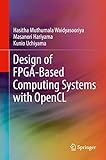Design of FPGA-Based Computing Systems with OpenCL [electronic resource] / by Hasitha Muthumala Waidyasooriya, Masanori Hariyama, Kunio Uchiyama.
By: Waidyasooriya, Hasitha Muthumala [author.] .
.
Contributor(s): Hariyama, Masanori [author.] | Uchiyama, Kunio [author.]
| Uchiyama, Kunio [author.] | SpringerLink (Online service)
| SpringerLink (Online service) .
.
Material type:  BookPublisher: Cham : Springer International Publishing : Imprint: Springer, 2018Edition: 1st ed. 2018.Description: IX, 126 p. 84 illus., 13 illus. in color. online resource.Content type: text Media type: computer Carrier type: online resourceISBN: 9783319681610.Subject(s): Electronic circuits
BookPublisher: Cham : Springer International Publishing : Imprint: Springer, 2018Edition: 1st ed. 2018.Description: IX, 126 p. 84 illus., 13 illus. in color. online resource.Content type: text Media type: computer Carrier type: online resourceISBN: 9783319681610.Subject(s): Electronic circuitsBackground.- Introduction to OpenCL for FPGA -- FPGA Accelerator Design Using OpenCL -- FPGA-Oriented Parallel Programming -- Exploiting the Memory Hierarchy -- Design Examples -- Index.
This book provides wide knowledge about designing FPGA-based heterogeneous computing systems, using a high-level design environment based on OpenCL (Open Computing language), which is called OpenCL for FPGA. The OpenCL-based design methodology will be the key technology to exploit the potential of FPGAs in various applications such as low-power embedded applications and high-performance computing. By understanding the OpenCL-based design methodology, readers can design an entire FPGA-based computing system more easily compared to the conventional HDL-based design, because OpenCL for FPGA takes care of computation on a host, data transfer between a host and an FPGA, computation on an FPGA with a capable of accessing external DDR memories. In the step-by-step way, readers can understand followings: how to set up the design environment how to write better codes systematically considering architectural constraints how to design practical applications Provides readers with an overview and practical examples of OpenCL-based design methodologies for FPGA-based computing systems; Helps software engineers to understand systematically patterns of parallel processing and implement such patterns using OpenCL for FPGAs; Includes a variety of design examples of embedded applications such as image processing, and high-performance computing.


There are no comments for this item.